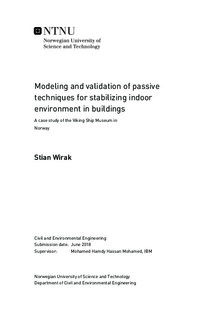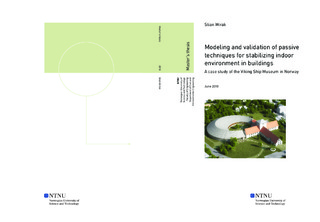| dc.description.abstract | This thesis investigates how Phase Change Material (PCM) and moisture buffering can stabilize the indoor environment by using a case study of the new Viking Ship museum at Bygdøy outside of Oslo. The museum stores a cultural heritage that is well preserved and needs to be taken care of in the new museum as well. Fluctuations of temperature and relative humidity can damage the artifacts, so the indoor environment needs to be planned carefully. PCM is a technology which uses latent heat (melting and solidifies) to store and release energy and can therefore be used to stabilize the fluctuations of temperature within the building. Moisture buffering is a phenomenon where materials absorb and release humidity from the surrounding air. Moisture buffering can therefore be used to stabilize the fluctuations of relative humidity within the building. Three research questions have been formulated for this thesis:
1. Does IDA ICE provide valid models for simulating the effects of moisture buffering and PCM?
2. Can moisture buffering and PCM improve the indoor environment in the Viking Ship Museum?
3. Can moisture buffering and PCM reduce the total energy consumption and peak energy demands for HVAC in the Viking Ship Museum?
IDA ICE by EQUA AB was selected as the simulation tool and EQUA provided models for both simulating PCM (i.e. PCM model) and moisture buffering (i.e. HMwall model). The validity of both these models has been tested in this thesis, in addition to a review on validation done by others. The PCM model was found to be valid, while the HMwall model was found to have limitations in the validity. The validation tests show that the HMwall model has limitations when simulating other materials than concrete (e.g. insulation). The HMwall model was therefore found not valid to simulate moisture buffering in the case study.
The case study has been divided in a single zone case study and a whole building case study. The single zone case study investigates how PCM can affect the indoor environment in one of the exhibition rooms and the HVAC systems was made constant to isolate the effect from PCM. Seven different PCMs were implemented and evaluated. The results from a simulated week in the summer showed that when PCM was implemented internally on the surface of the concrete, the average mean air temperature decreased with about 1°C, but the temperature fluctuations increased.
The whole building case study was in difference to the single zone case study implemented with sensor-controlled HVAC systems. Two different PCMs were implemented into one of the exhibition rooms, and the stabilization effect on the indoor environment, along with the energy consumption and peak energy demand, was investigated. The results showed that by implementing PCM, the energy consumption for HVAC could be reduced with 0.27% and the peak energy demand for fuel heating by 0.26%. The highest reduction of temperature fluctuations was found in the summer simulation, where one of the PCMs managed to reduce the Temperature Stabilization index (TS) by 2.56%.
The main reason for such low effect from PCM is that the PCM was implemented in a concrete building with high thermal mass and the implementation reduced the exposed surfaces of concrete. In addition, the thermal conductivity of PCM is low compared to concrete, which implies that concrete manages to store and release heat to the indoor environment faster than PCM. The PCMs were found to only use an average of about 6% of the potential daily energy storage. The results showed that only about 11 kJ/kg was stored or released as an average during 24 hours, while the implemented PCMs had a potential of storing or releasing 183 kJ/kg. The highest change in enthalpy during 24 hours was found to be about 29 kJ/kg, which is 16% of the potential of the implemented PCMs. | |

